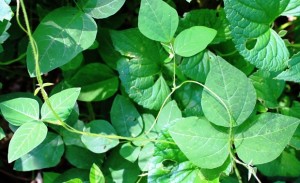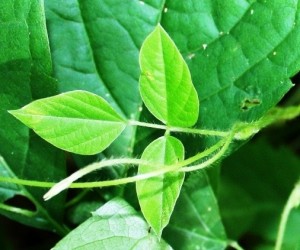Hog-peanut (Amphicarpa bracteata) is a delicate twining annual vine that may grow to 5’ in length, gently climbing onto and over nearby plants. Leaves are clustered into leaflets of three.
At first glance, hog-peanut could be confused with poison ivy which has similar looking 3-leaflet clusters. These plants also share similar woodland habitats. Here are their differences:
– hog-peanut leaves are slightly furry or hairy versus the often shiny leaves of poison ivy
– hog-peanut twines as its length increases, poison ivy does not twine
– hog-peanut leaves are 1 to 3” long, smaller than poison ivy leaves which are 3 to 4” long
– hog-peanut has a herbaceous stem, poison ivy has a woody stem
The curious sounding name, hog-peanut, is derived from rounded seed pods that form near the plant’s base or sometimes below ground. Ferrel hogs of yore probably rooted around to find those peanuts below ground.
Anybody have other ideas about the origin of hog-peanut’s common name?
To view a great photo of a flowering hog-peanut and many other native plants, click on this link which will bring you to the University of Purdue website – flowering hog-peanut. Plan on spending some time at the rest of their plant web site: http://www.ipfw.edu/native-trees/Wildflowers-Page2.htm. The quantity and quality of their plants photos is awesome!
Do you know what’s growing in your woodland? Take a nature break and head outside!
Cheryl Jirik
Landscape Restoration, Inc.




